Dave the Taxi Driver's
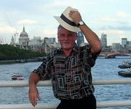 Guide to London
Guide to London
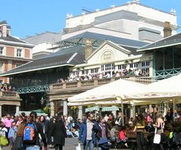
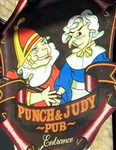
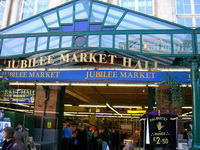
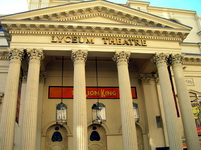
|
| ||||
|
Dave the Taxi Driver's | ||||
|
|
| |||
 |
|
 |
 |
|
Covent Garden (WC2)
So there I was, having made a short visit to the award winning toilets by St. Paul’s Church, when I suddenly became aware that I was being followed. Not only being followed, but followed at speed by a man who was leaping like Roald Dahl’s BFG, amid the sound of raucous laughter. I had made a mental note of this comedian, in case I became one of his stooges. His act was in progress in the Piazza as I approached these award winning toilets ( award winning because some years ago they were kept spotless and had piped music and friendly attendants, but not too friendly, if you know what I mean). At some distance from where I was walking the comedian was running skillfully behind people and mimicking them, to the delight of the on looking audience, but I had momentarily forgotten about him. As far as I am aware this is the first time this has happened to me as I have emerged from a gents, or from anywhere for that matter. I certainly have never consciously encouraged this form of behaviour, nor have I given the impression that I am receptive to it. And I certainly have not followed any……..anyway… this is Covent Garden, the home of street theatre within Theatreland; the natural stage for London tourism. Covent Garden covers the area from the Strand up to Shaftesbury Avenue/High Holborn. Leicester Square Tube station is on the western boundary just across the Charing Cross Road from Chinatown and Soho. The old official boundary to the east is Drury Lane. I must say that I would be splitting hairs if I only mentioned the north of the Strand where Covent garden is situated, without including the area that leads down to the River Thames. That would mean leaving out the Savoy Hotel, the Savoy Theatre and in Savoy Row the Savoy Chapel, built in 1512. All these buildings stand on the site of the mediaeval Savoy Palace. This was destroyed by Wat Tyler and his rebels when they attacked and pillaged London during the Peasants’ Revolt of 1381.Simpson’s classy restaurant is nearby at 100 Strand. Villiers Street by Charing Cross Station has the Players Theatre. At the far end of Northumberland Avenue (one of the maroon ones on the Monopoly Board) is the Playhouse Theatre. There is a little cut through near here that is known to Taxi drivers which goes underneath all the buildings and which leads to the City. Nothing fantastic but when I go through here, having avoided the traffic around Charing Cross, I always feel as though I have achieved something. Victoria Embankment Gardens are adjacent to Embankment Tube Station. The large arch which is situated in the north west corner of the gardens was built in 1626 was formerly the water gate to the mansion of York House. This was a former residence of the Archbishops of York before it was acquired by the Duke of Buckingham. The arch used to be on the river bank but now stands a considerable distance away. The River Thames used to be much wider before the construction of the Embankment and sewer system by Sir Joseph Bazalgette in the nineteenth century. Open air concerts are held in the gardens throughout the summer. At the far end of the Strand beyond the Royal Opera House, the Aldwych and Kingsway begins the City of London where, away from the frivolity of Covent Garden, much different and more serious activities take place. Covent Garden is full of entertainment and tourists, whereas the City is full of lawyers, accountants and merchant bankers. It was in Covent Garden that some of the now famed businesses began, Sainsbury’s, Moss Bros. and Sotheby’s. The Waldorf Hotel in the Aldwych featured as a location in the movie Titanic.
The Piazza is pedestrianised as is much of the area, so it has a comfortable quiet feel to it away from most of the roaring traffic and noise along the Strand etc., allowing for the usual snail pace of London traffic that is. At the bottom of Monmouth Street stands the little circle called Seven Dials. This area was developed by Thomas Neale in the 1600s with the intention of attracting the rich and to make it one of the finest addresses in London. Seven streets lead away from the circle. The idea was to cram as many houses into the available space so that Neale could make much more money from the development. There is a tower in the centre of the circle. On this tower there are six faces of sundials, not seven as you would expect. The reason for this was that originally the plans were to build only six streets of houses but a profit motivated rethink changed the plans. The monument therefore is a little out of sync with its surroundings. It was built in 1694. Seven Dials never really made it as an exclusive area and by the 1800s it had become a den of gin houses with alcoholic patrons, surrounded by overcrowded slums. William Hogarth depicts what it must have been like in his engraving ‘Gin Lane’. Since the seventeenth century the design of Seven Dials, with the sundials and the star- like layout has always attracted those who practice alternative medicine and dwell in the mystic side of life. It is still the same in the present day. There are New Age stores such as Mysteries on Monmouth Street. Neal’s Yard, a bustling, winding alleyway has a number of vegetarian cafes and homeopathic remedy, organic and occult interest shops. It really is an interesting place in which to wander.
Covent Garden Market officially began in the Piazza in 1670 when it received its licence from Charles II. It flourished for over three hundred years. In 1830 Charles Fowler built the central market building. The flower market used to be where the London Transport Museum now stands. It was realised well before 1973,when the market eventually closed, that the area had become far too congested and that the market would have to be relocated. It was moved to the much larger warehouse based site in Nine Elms Lane(SW8). By the eighteenth century, when the market was in its hey day, Covent Garden had already become a well known red light district. It was also rife with ne’er do wells, constant noise and disturbances. These factors contributed once again, as with other areas of London, to make the affluent residents of the Piazza to move away to the more fashionable areas such as Bloomsbury and Mayfair The old stone market building still possesses an almost haunting air. It has retained its classical character despite its new role as a shopping, dining and entertainment centre. When the market closed there was an attempt by developers to demolish many of the old buildings and replace them with modern hotels and conference centres which would have necessitated building access roads cutting right through the area. What a disaster that would have been! Fortunately a public campaign against the plans was successful. This resulted in many of the historical buildings being listed as protected. This led the way to the renovation of the central market building during the 1970s. Since the completion and opening in 1980, the cobbled streets and alleyways all around have blossomed into a mecca for visitors and they are constantly a hive of activity and energy. |
|
The newly refurbished church of St Martin in the Fields stands high by the north eastern corner of Trafalgar Square, not in fields any more. Originally a small chapel stood here in the eleventh century. The monks, probably from Westminster Abbey worked in the convent garden. This gave its name to the whole area. It was rebuilt in the sixteenth century and paid for by Henry, Prince of Wales. In 1722 it was again rebuilt by Sir James Gibb. The new large rectangular building, straddled by a portico and possessing a high steeple is in the style of many American churches. This is the church we see today. Buried here are Nell Gwynne, mistress of Charles II, painter/ printmaker William Hogarth, artist Sir Joshua Reynolds, Thomas Chippendale, the cabinet maker and the notorious highwayman Jack Sheppard. St. Martin’s is also famous for the wealth of classical music concerts which number around 350 per year and its choral excellence. St. Martin’s is known as the Royal Parish Church. Two royal babies have christened here, Charles II and our current Prince Charles. |
|
Theatres
The English National Opera is based at The Coliseum, St. Martin’s Lane. As well as opera there are many ballet productions. Tchaikovsky’s The Nutcracker is usually performed during the Christmas period. Of course Agatha Christie’s “The Mousetrap” is still playing at St.Martin’s Theatre, West Street ,WC2. The longest run ever, it celebrated its 50th anniversary in 2002. The grandiose Royal Opera House in Bow Street was almost completely reconstructed throughout the1990s. It is the third theatre to stand on the site, the original having been built in 1732. The theatre is known as ‘Covent Garden’. |
|
Here is a list of theatres in Covent Garden: -
Adelphi 410/411 Strand |
|
Punch and Judy
He acquired a wife and moved to the seaside. The shows have delighted audiences of children ever since. In case you don’t know, the seaside shows take place in a striped upright tent with a little stage on top. Using his famous large stick, the shows consist of Punch battering anyone who tries to exert their authority over him or harm him and justifying his actions by shouting in his squawky voice, “That’s the way to do it”. He has been considered a representation of a psychopathic murderer by those of the politically correct persuasion. There were moves to ban these shows because of the potential mental harm to children who might perceive that domestic violence is acceptable. I may be wrong but I have never heard of a wife batterer blaming his actions on a Punch and Judy show that he saw when he was seven years old. Punch certainly does not depict a benign individualist, but maybe something more subtle is being said. Perhaps we all need to be suspicious of anybody who tries to strait jacket our thoughts and behaviour; to have a healthy questioning attitude of anyone who tries to impose their authority regardless of their stated reasons. Yes I did watch Punch and Judy on the sands of Southport many years ago. Children love him. The shows are still going strong although the characters are often adapted nowadays to reflect modern times. It all started in Covent Garden. Tube:- Covent Garden, Leicester Square, Holborn, Embankment, Charing Cross (National Rail) Any questions? E-mail me For tours, transfers and other taxi services see Dave's Taxi Page |
|
|